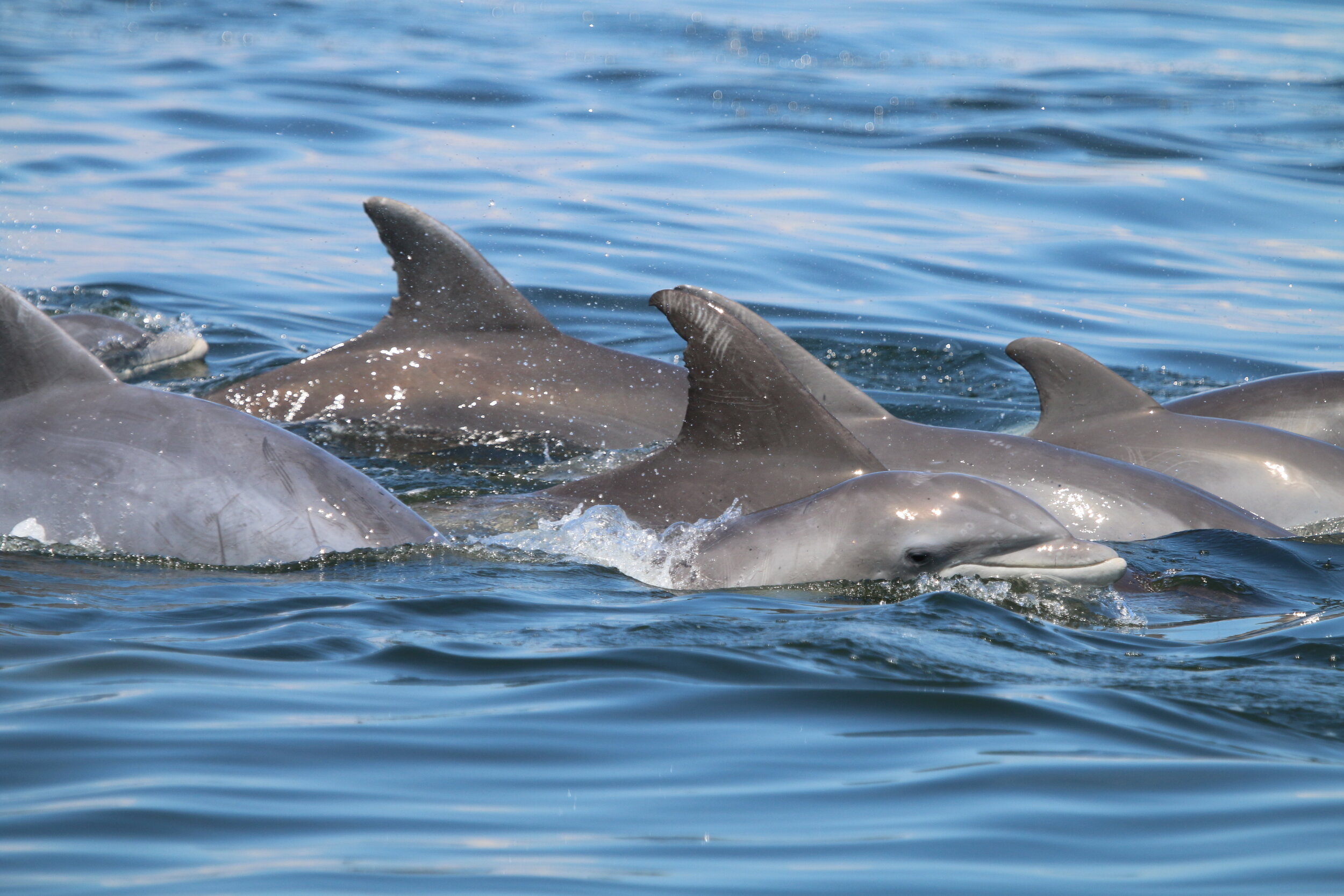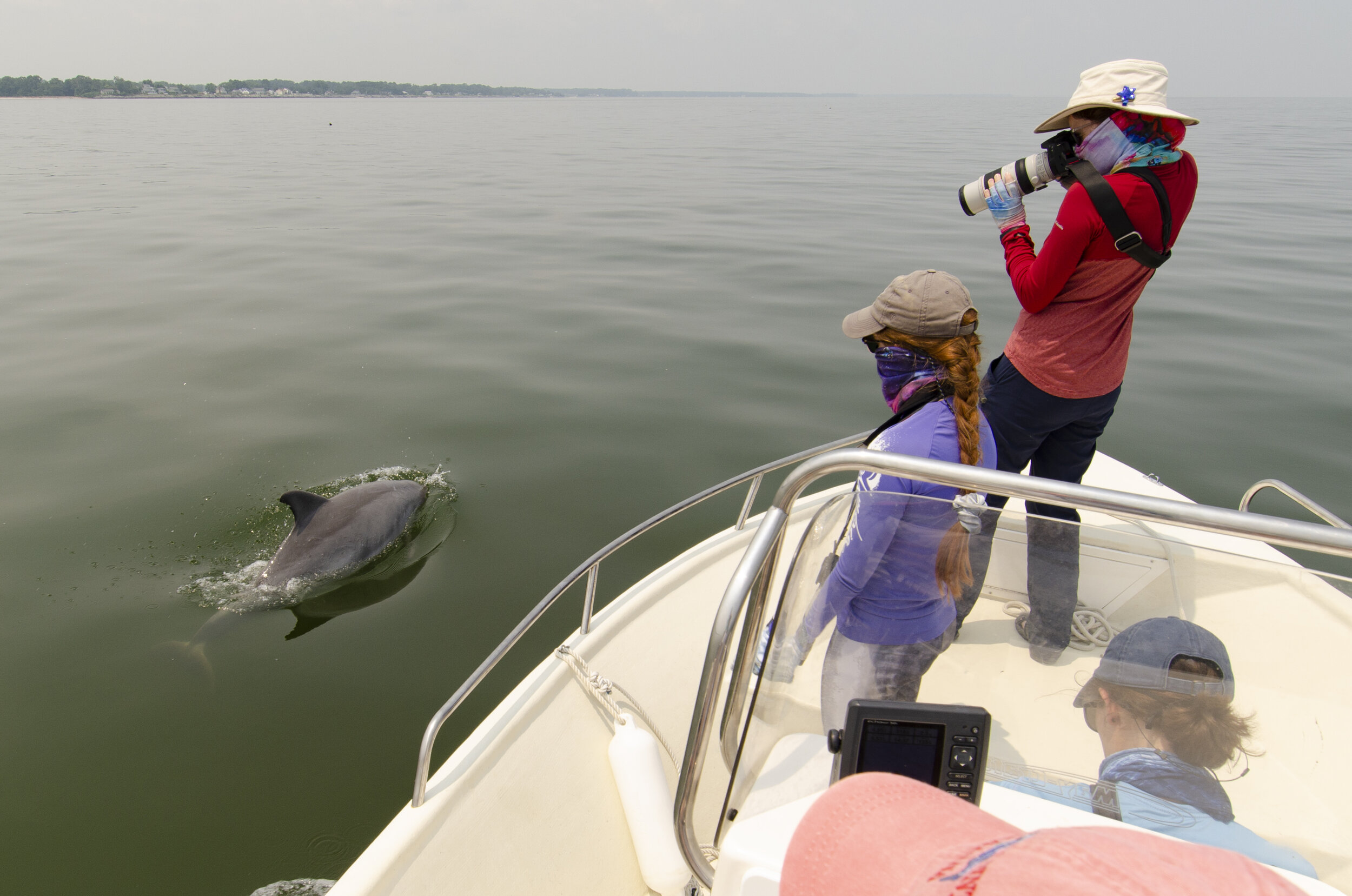Potomac River dolphins also suffer from viral outbreaks - Here’s how to help
/Checking up on the health of the dolphins in our local waters!
IMAGE COURTESY OF ANN-MARIE JACOBY, THE POTOMAC-CHESAPEAKE DOLPHIN PROJECT. TAKEN UNDER NMFS PERMIT NO. 19403
Guest Author
Ann-Marie Jacoby
Associate Director, Potomac-Chesapeake Dolphin Project
Potomac Conservancy is pleased to bring you another blog in our series on the dolphins of the Potomac River 🐬, from Potomac-Chesapeake Dolphin Project (PCDP) Associate Director Ann-Marie Jacoby.
Just like people, dolphins are susceptible to disease outbreaks. Unlike us, however, they cannot rely on public health regulations or modern medicine to stymie its impacts.
Our research group, the Potomac-Chesapeake Dolphin Project, was founded by Georgetown University Professor Janet Mann in part to study an airborne viral outbreak that caused a mass mortality event among Potomac River and Chesapeake Bay dolphins.
So what have we discovered about how and why disease spreads amongst our local dolphin population? How healthy are they now? And how can we keep them healthy and prevent more outbreaks?
Here’s what we know, and what we still need to find out…
Bottlenose dolphins swim in the Potomac River Along the Northern Neck of Virginia. Image courtesy of Ann-Marie Jacoby, the Potomac-Chesapeake Dolphin Project. Taken under NOAA NMFS Permit No. 23782.
What happens when disease breaks out among dolphins?
In 2013, after noticing an unusually high number of dolphins stranding along shores from New York to Florida, the National Oceanic and Atmospheric Administration declared an Unusual Mortality Event. Between 2013 and 2015, over 1600 dolphins washed ashore along the US East Coast, and some populations are estimated to have suffered 20,000 deaths, losing half of their population.
The culprit for this mass mortality was an airborne virus known as the cetacean morbillivirus. Closely related to the measles virus, morbillivirus is a highly contagious and deadly disease that seems to plague dolphin populations along the east coast every few decades when herd immunity has weakened. (That is, those that developed immunity during a previous outbreak are no longer alive to keep the spread of infection amongst dolphins that don’t have immunity at bay.)
The last morbillivirus outbreak occurred from 1987-88 and also caused hundreds of dolphins to strand and severely decreased population sizes.
Drastic declines in population size can have long-term consequences on the health
of dolphin populations by making them less resilient to future disease outbreaks and other human disturbances, such as habitat degradation.
Barbara Bush's calf swims along side her and surfaces to breathe. Like humans, dolphins invest a lot of time into the raising of each calf, making it harder for their populations to recovery quickly from mass mortality events. Image courtesy of Ann-Marie Jacoby, Potomac-Chesapeake Dolphin Project. Taken under NOAA NMFS Permit No. 19403.
Dolphins are slow to grow, late to mature, and can live into their 60s. Females only start breeding at the age of 10, have one calf per birth, and take between 2-4 years to raise their calves. Consequently, their populations are particularly vulnerable to sudden changes and slow to recover from them.
In both morbillivirus outbreaks, the virus’ origin is thought to have come from pilot whales living in offshore waters along the Atlantic Ocean’s continental shelf break. Pilot whales are suspected to be asymptomatic carriers of the cetacean morbillivirus, meaning they carry the virus but don’t exhibit any symptoms.
Dolphins living in offshore waters will swim in groups with pilot whales and likely contract the virus when they break the surface to breathe alongside the whales, exchanging respiratory droplets.
Why are dolphin populations so susceptible to the spread of airborne diseases like morbillivirus?
The lung capacity of dolphins is large to maximize the amount of time they hunt underwater, and their exhalations and inhalations at the surface are quick and powerful to minimize their time at the surface.
Dolphins only take a few breaths every minute with each breath ranging between 5-18 liters (or over 3x our full lung capacity!) and at a rate several times faster than one of our coughs.

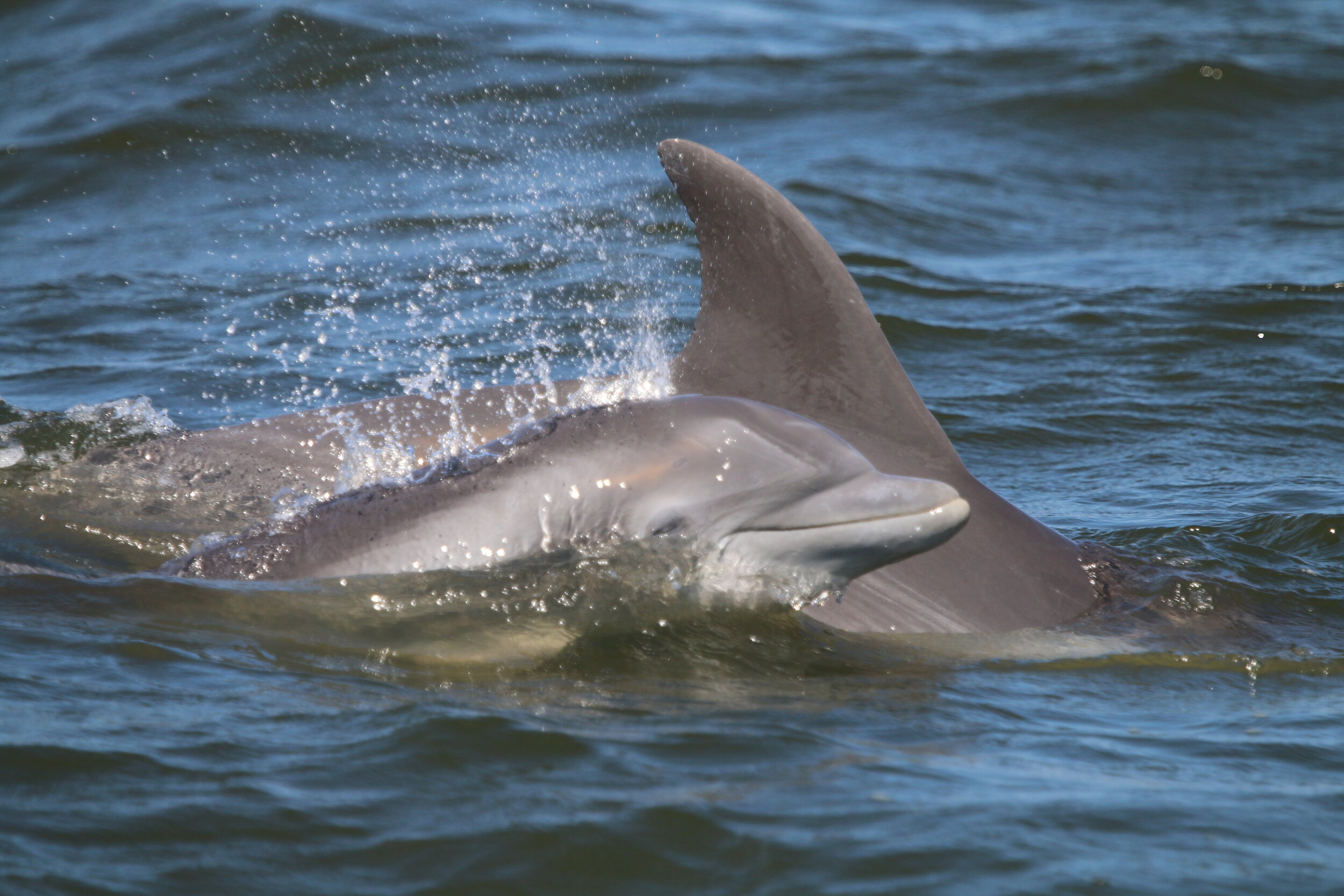
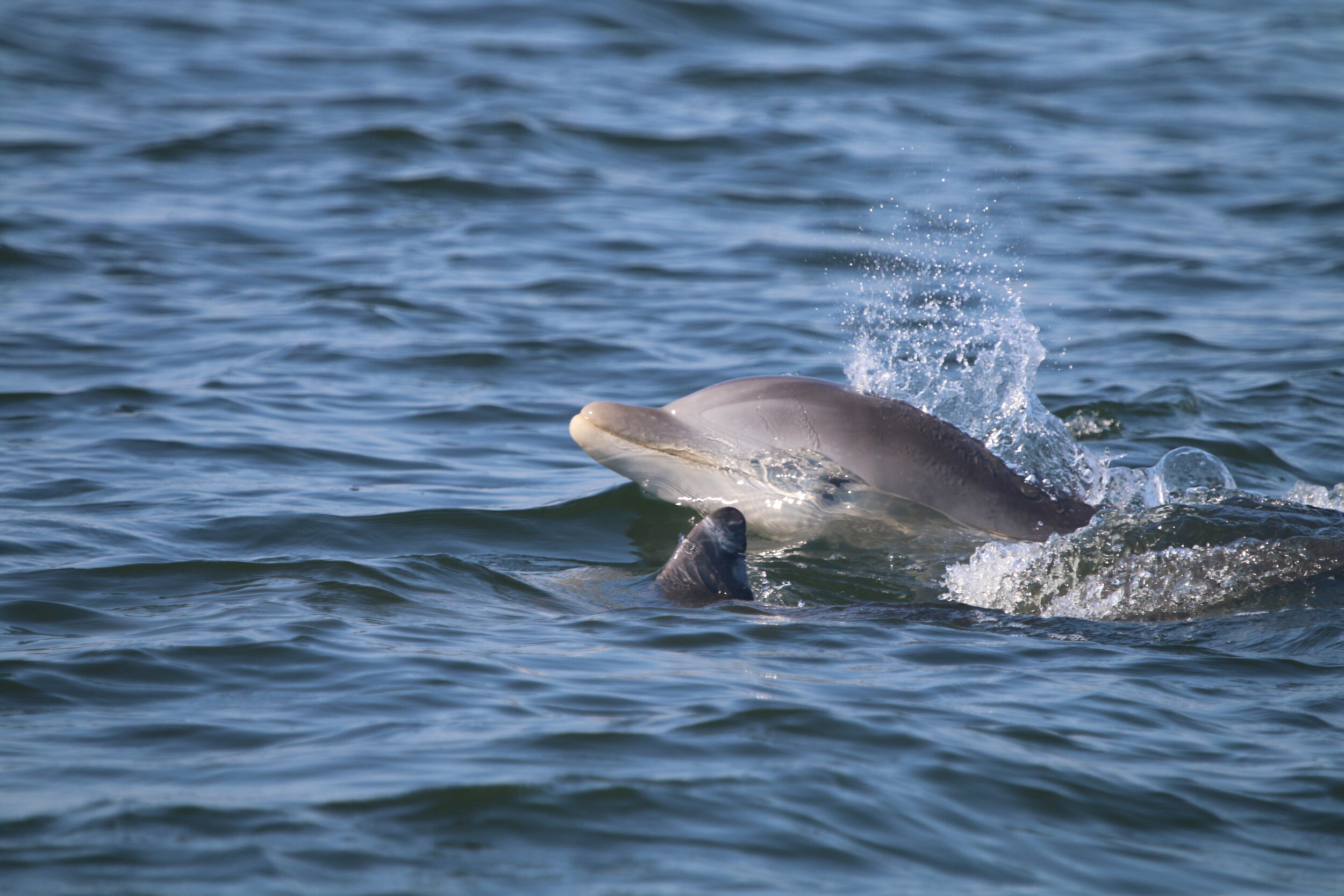
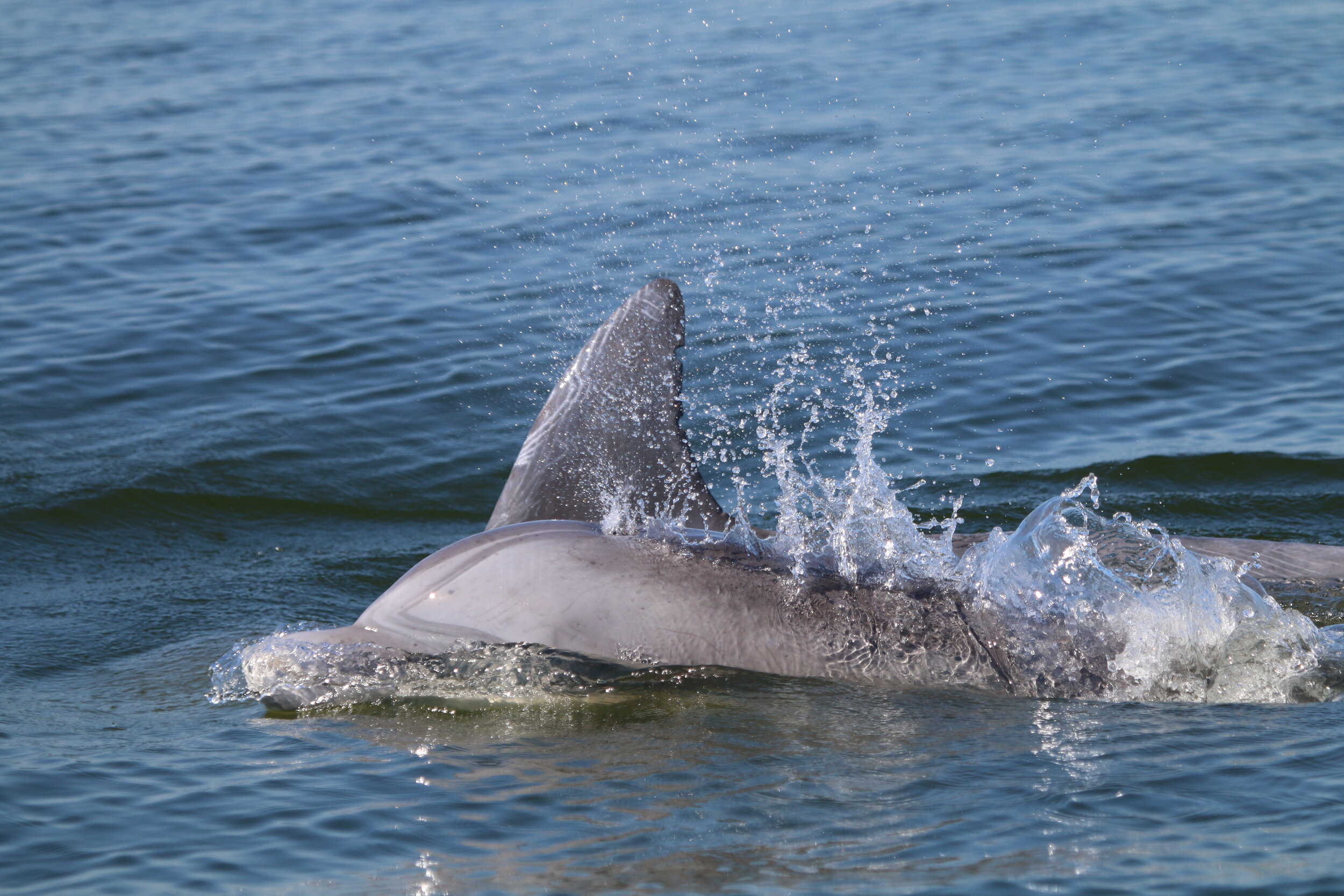
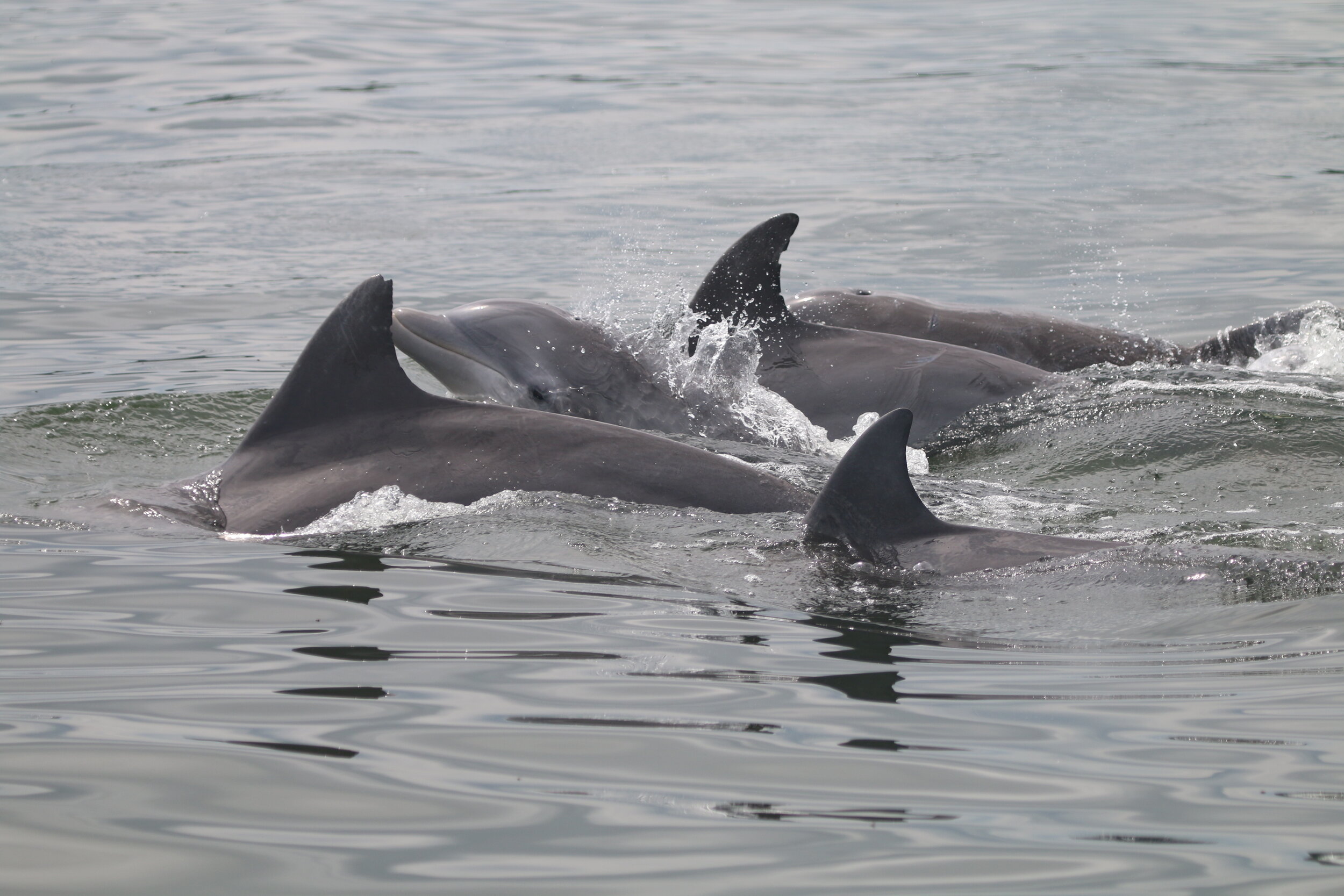
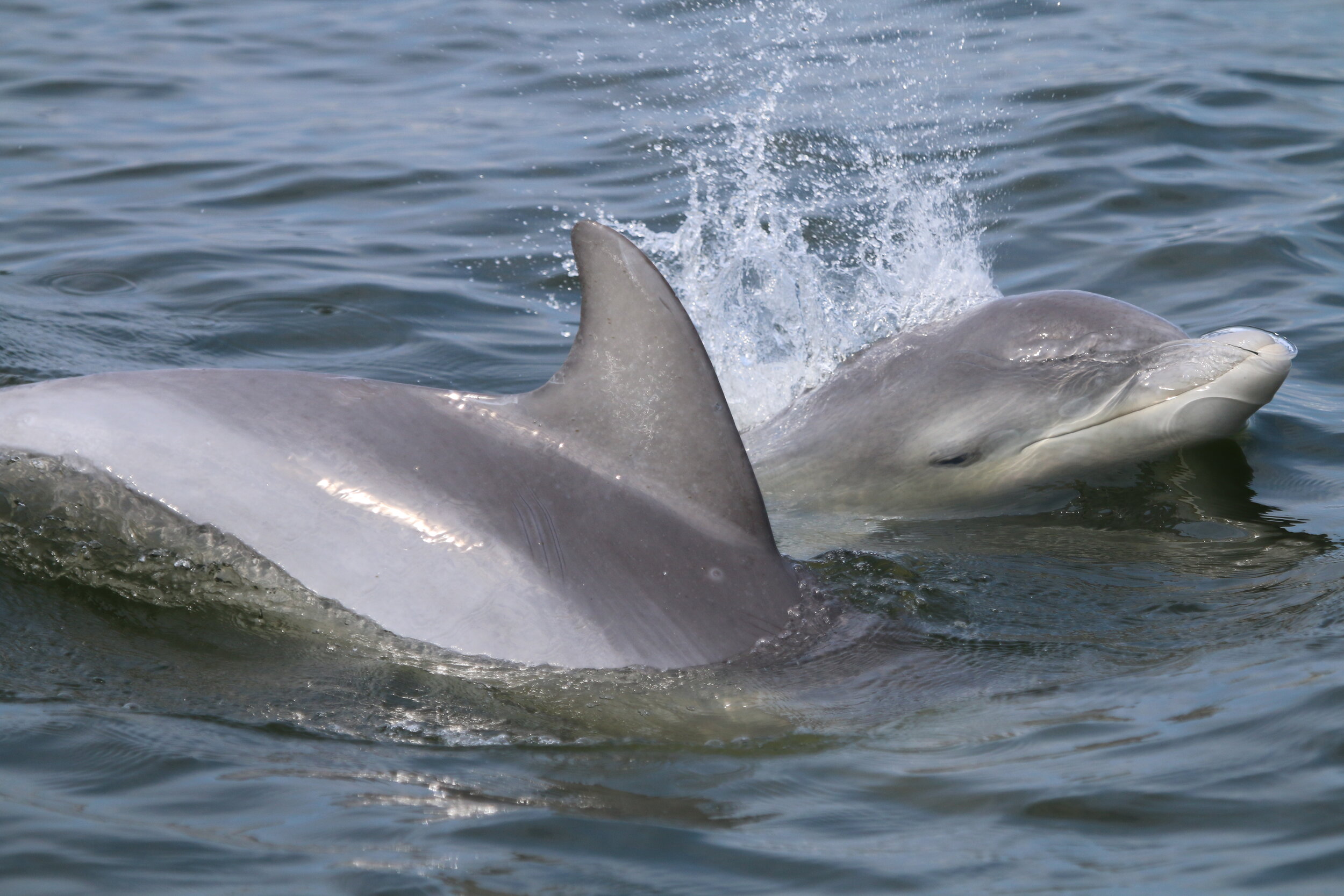
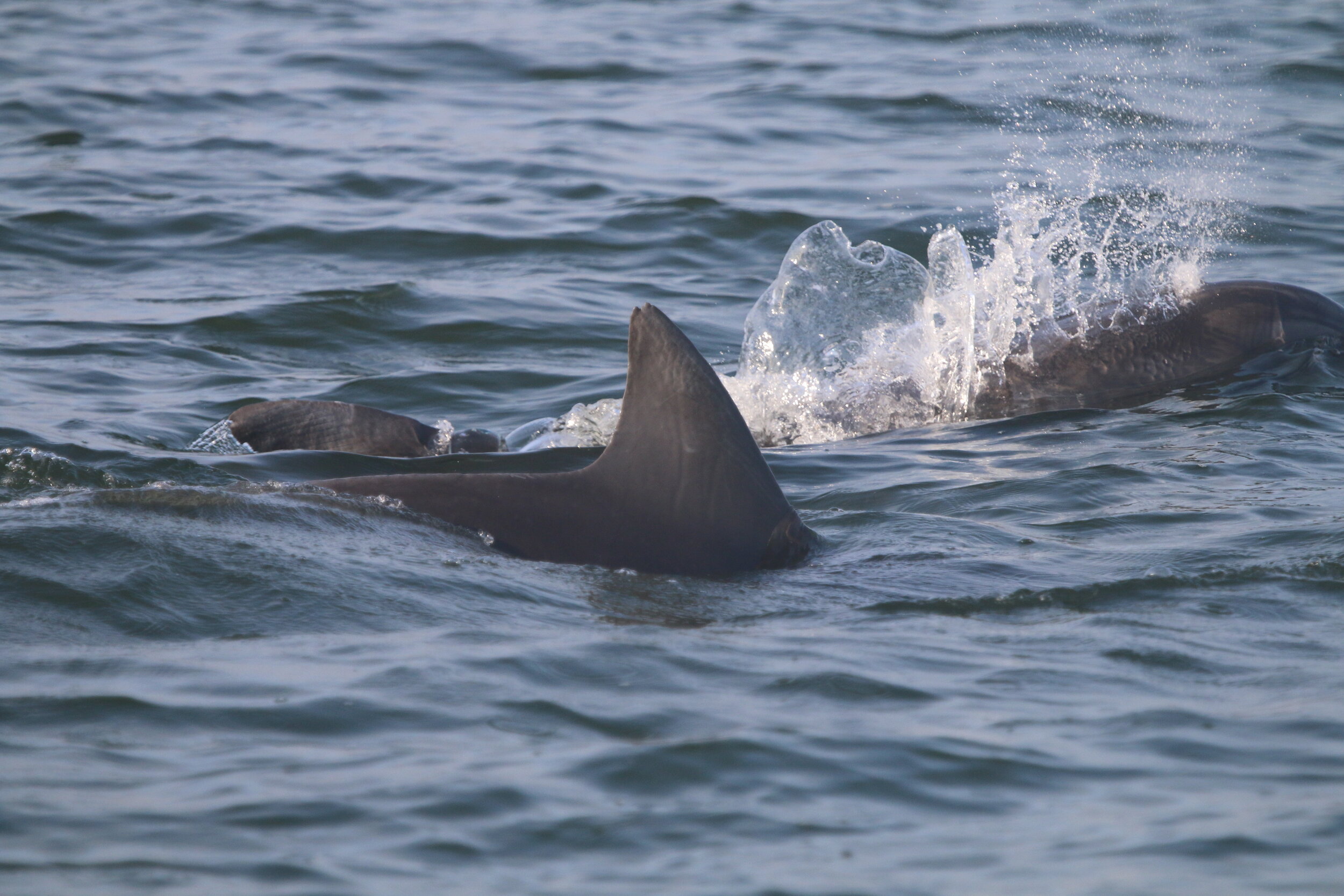
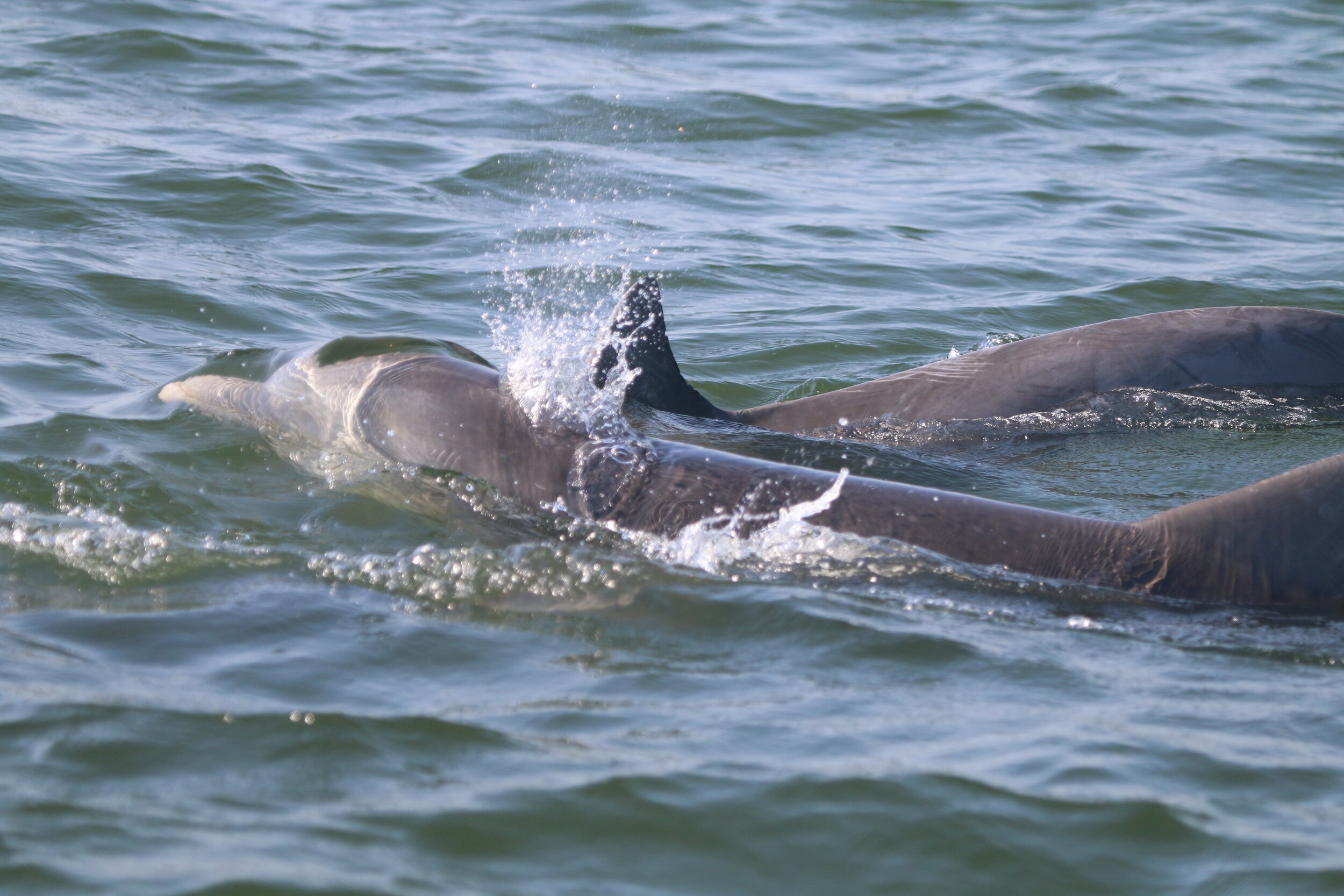
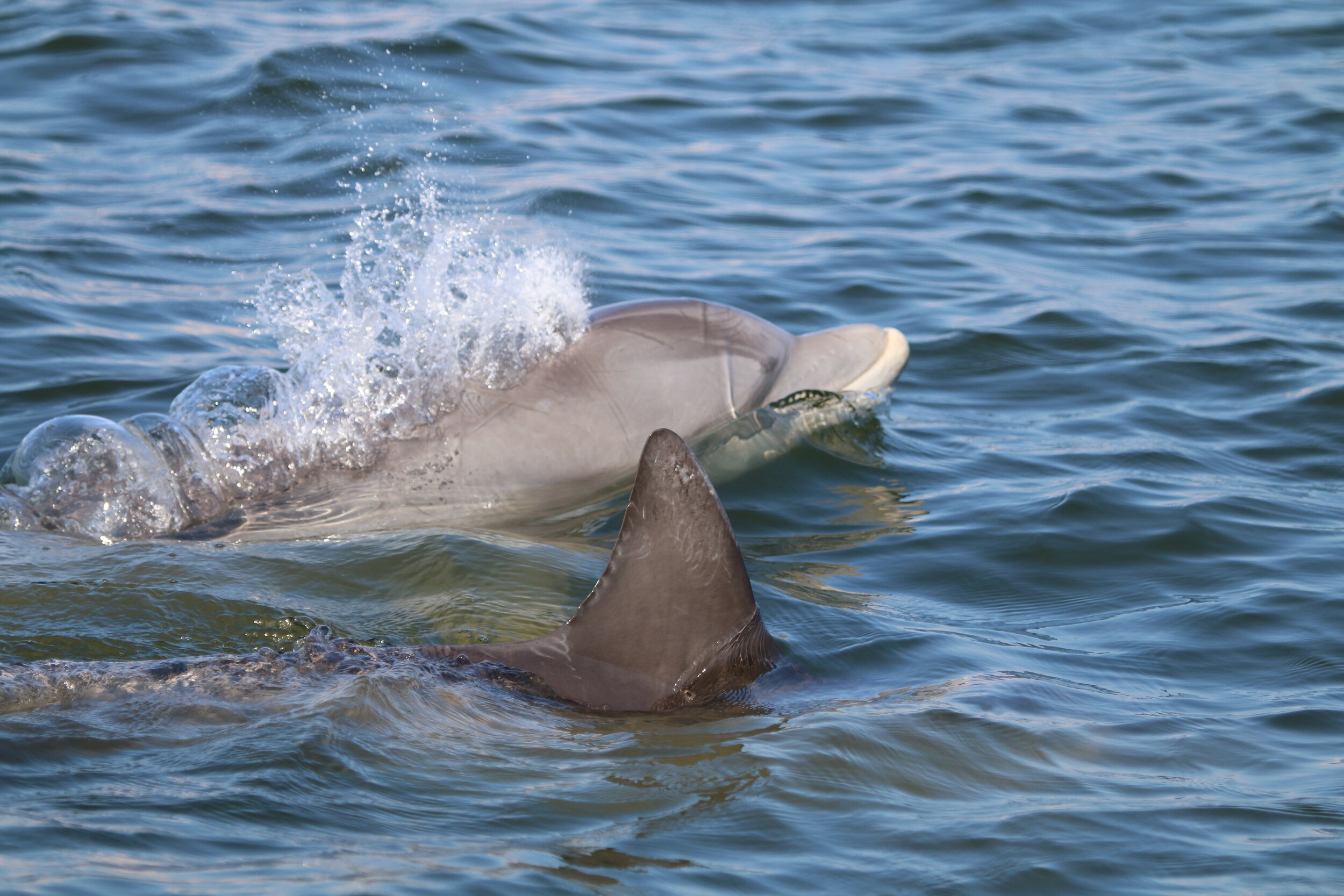
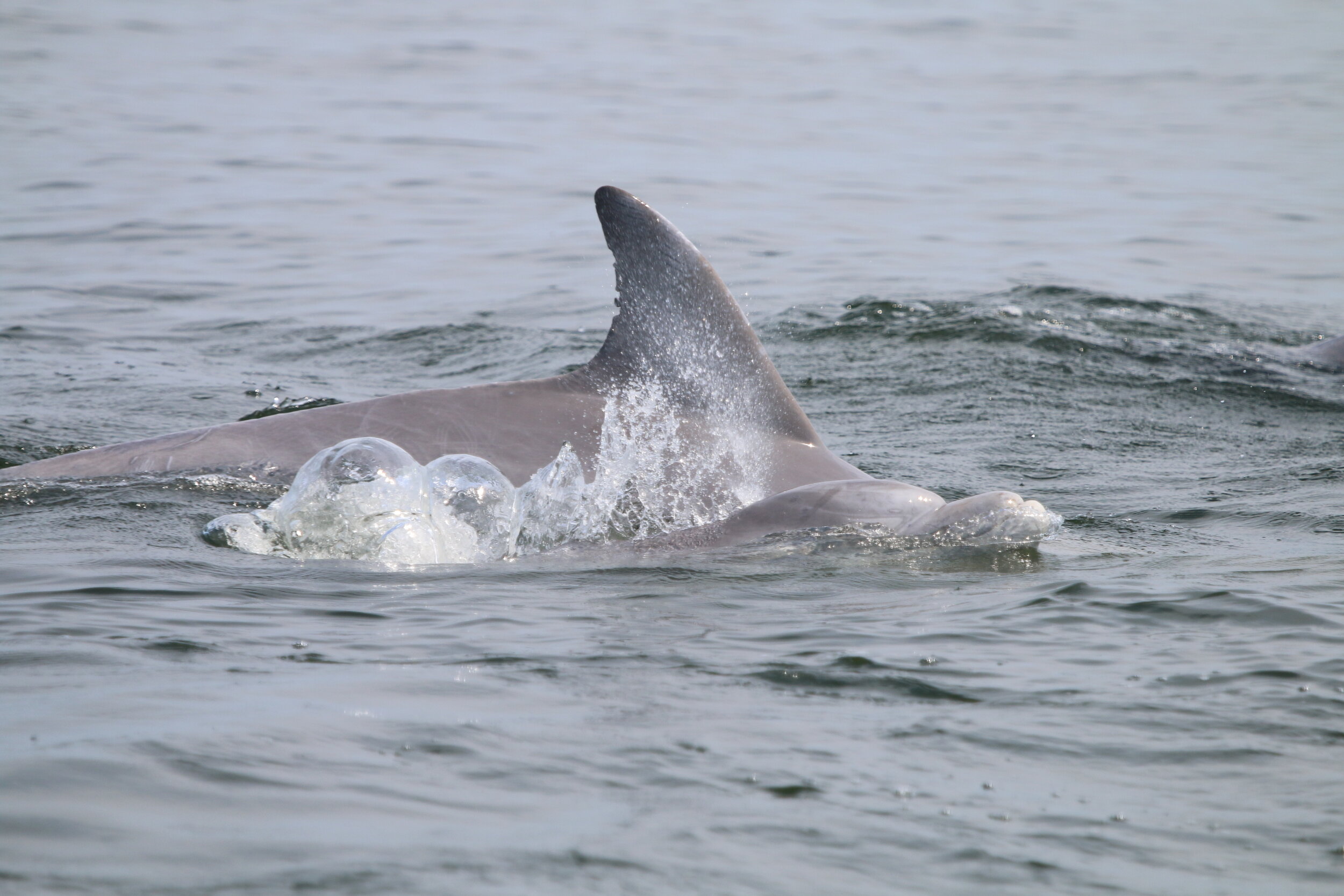
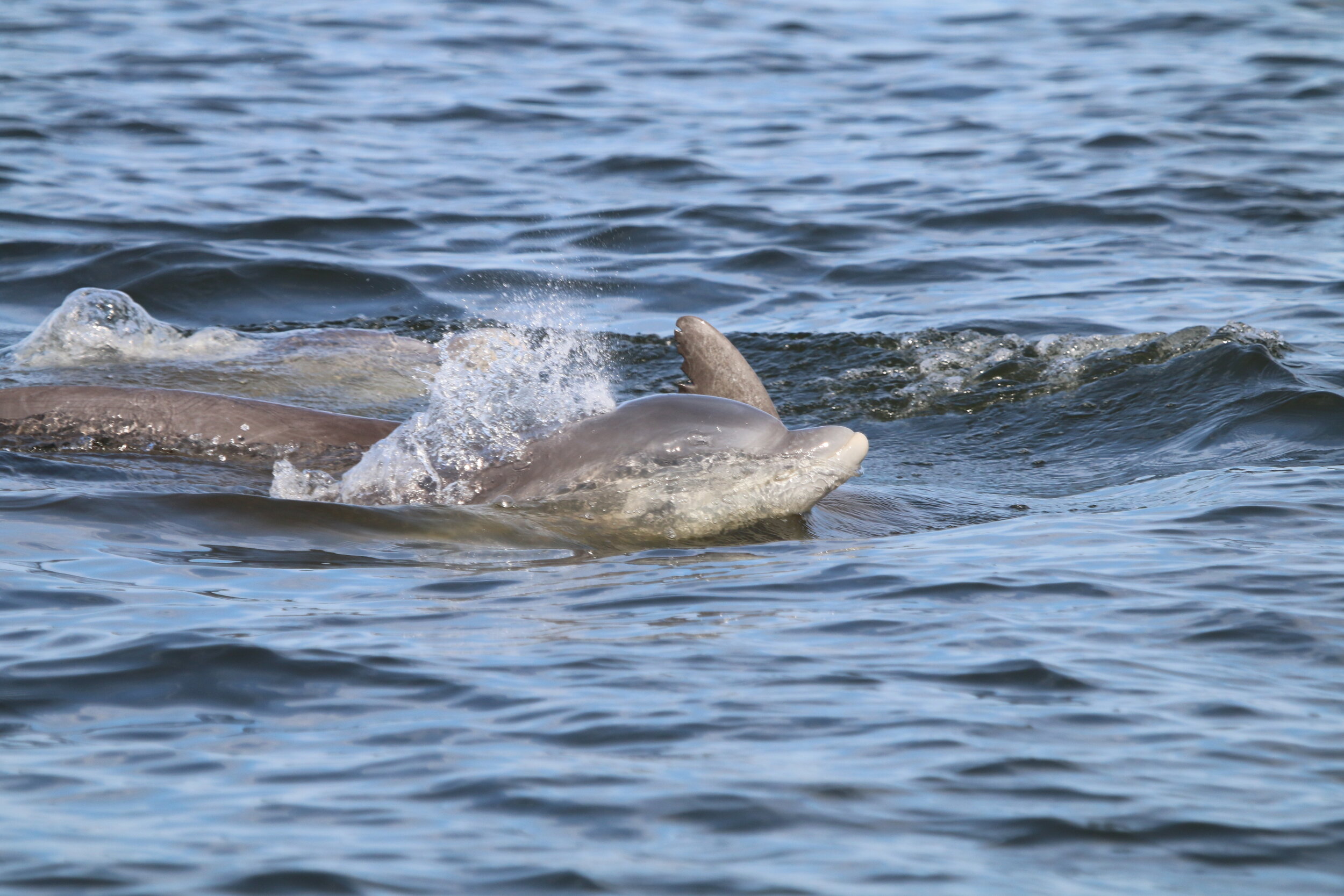
Respiratory droplets and water can be seen as a Potomac River dolphins break the surface to breathe. Images courtesy of Ann-Marie Jacoby, the Potomac-Chesapeake Dolphin Project. Taken under NOAA NMFS Permit No. 19403.
As highly social animals, dolphins also have a tendency to coordinate their dives, ascents, and movements at the surface with other dolphins.
Groups of dolphins can become very large and tight knit with multiple individuals sometimes less than a foot apart from one another. The average number of Potomac dolphins in a group is 19 but groups can reach over 230 dolphins!
A synchornized surfacing sequence of dolphins in the Potomac River shows how tightly-knit large groups of dolphins can be. Image courtesy of Meliss Collier, Potomac-Chesapeake Dolphin Project. Taken under NOAA NMFS Permit No. 23782
Furthermore, the composition of groups is constantly changing, meaning who a dolphin associates with can vary by the minute, hour, day, or week – similar to people (well, before the pandemic, anyway 😕).
The continuous formation and diffusion of different individuals into groups allows disease to spread beyond the initial patient 0 group and to new individuals.
As an example, imagine an auditorium with over 200 people in close proximity to one another, so close they sometimes touch elbows. They move about the room to mingle and several times per minute everyone coordinates coughing out loud and forcefully. Within an hour, some people leave the auditorium to meet up with others elsewhere, while new individuals join the auditorium gathering.
You can image how rapidly an airborne disease would spread in this situation - such is the case for dolphins.
Dolphins tend to travel in large groups aiding the spread of airborne viruses. Image courtesy of Ann-Marie Jacoby, the Potomac-Chesapeake Dolphin Project. Taken under NOAA NMFS Permit No. 19403.
How does morbillivirus spread along the entire US Eastern Seaboard?
The short answer is we still don’t fully know!
Dolphins reside in waters from New York to Florida. Some populations are year-round residents remaining within defined regions along the coast, while other populations live and move along different parts of the coast depending on the time of year, like snowbirds. As a result, dolphins from different populations end up overlapping during different times of the year.
The Potomac-Chesapeake area may be vital to understanding the spread of morbillivirus along the coast, because the first strandings for both the 1987 and 2013 morbillivirus outbreaks were in Virginia waters and multiple populations of dolphins that move between New Jersey and North Carolina overlap in the Potomac on a seasonal basis.
Melissa Collier studying the surfacing behaviors of Potomac dolphins from the PCDP research vessel, Ahoya. Image courtesy of Ann-Marie Jacoby, the Potomac-Chesapeake Dolphin Project. Taken under NOAA NMFS Permit No. 23782.
To help understand how morbillivirus spreads along the entire US Eastern Seaboard and mitigate future outbreaks, Georgetown University Ph.D. Candidate Melissa Collier and the PCDP team are examining the mixing of these populations and the contact rates of individual dolphins in the Potomac.
the pcdp research team studying the potomac population from the PCDP Research vessel. Image courtesy of the potomac-Chesapeake dolphin Project, Taken under NMFS Permit No. NO.23782
Collier is comparing photographs of dorsal fins collected by researchers from Florida to New York to understand the mixing of populations. The dorsal fin shape and any notches, nicks, and scaring are unique to individuals, like our faces, and can be used to identify dolphins across time and locations.
These photographs are stored in the Mid-Atlantic Bottlenose Dolphin Catalog housed at Duke University and curated by Kim Urian. This catalog is a part of a collaborative effort among independent researchers and the National Marine and Fisheries Service to improve management of dolphins in US waters. Collier is helping in this matching effort, so that she can have as comprehensive an understanding of the overlap of populations all the way from New York to Florida.
Potomac dolphin James Madison has been sighted off of Beaufort, NC in the early Spring using the Mid-Atlantic Bottlenose Dolphin Catalog. Photos courtesy of Ann-Marie Jacoby, Potomac-Chesapeake Dolphin Project and Kim Urian, Duke University Marine Lab. Taken under NOAA NMFS Permit No. 19403 and 19903, respectively.
To determine the rate of transmission, Collier and the PCDP team are collecting data on individual dolphins. She is tracking how many times they break the surface to breathe alongside other dolphins and how close to one another they are. In other words, she is collecting data on their contact rates.
Under the advisorship of Dr. Shweta Bansal, Collier will implement the data on contact rates and what she learns about the population structure in a disease transmission model. This is a computer program that simulates how disease spreads through populations, so that she can predict the speed and degree of spread along the coast.
In Collier’s words, “these models allow us to predict the potential severity of future epidemics, as well as when and where they are most likely to occur.”
What can be done to mitigate disease outbreaks in the future?
Disease mitigation tactics are difficult to implement in the midst of an outbreak, but Collier believes these disease transmission models are the first step to protecting these vulnerable dolphin populations.
Collier added, “the results of these models can help wildlife managers know where and when to implement policies that lessen human disturbances in real time, which have been shown to worsen disease, in order to lessen the burden of infectious disease outbreaks in dolphins.”
Mitigating human disturbances is crucial because they cause stress, decreasing immune function and making dolphins more susceptible to disease.
How can you help?
As Collier stated, disease outbreak is exacerbated by human disturbance, such as pollution, heavy boat traffic, and marine debris. So what can we do to reverse the harm?
Being good stewards of the environment is an easy and critical way to decrease these disturbances. Advocating for improved, climate-friendly infrastructure to mitigate polluted runoff and reducing waste are two ways you can make a difference.
For those of you that recreate in the Potomac, maintaining a safe distance from dolphins is key to reducing sound pollution and avoiding accidental injury. Dolphins use sound to communicate and hunt but boat engines can drone out their ability to do either. Under the Marine Mammal Protection Act, people must remain 50 yards or half a football field away from dolphins.
It is important to identify disease early on. If you see a dead dolphin while out on the Potomac, please report it to the Virginia stranding hotline at (757) 385- 7575 or the Maryland stranding hotline at 800-628-9944. They will determine the cause of death.
Lastly, this work is costly given the equipment, boat fuel, personnel, and living costs associated with data collection. Donations are immensely helpful in covering these costs. If you would like to donate to this research project, please visit our donation page.
About the Expert
Ann-Marie Jacoby is a PhD Candidate in Marine Science and Conservation at the Duke University Marine Lab, as well as the Associate Director of the Potomac-Chesapeake Dolphin Project. Her doctoral research focuses on the historic and present-day occurrence of bottlenose dolphins (Tursiops truncatus) in the Potomac River and middle Chesapeake Bay to improve the conservation of mid-Atlantic bottlenose dolphin populations and the Potomac River-Chesapeake Bay ecosystems they are a part of.









